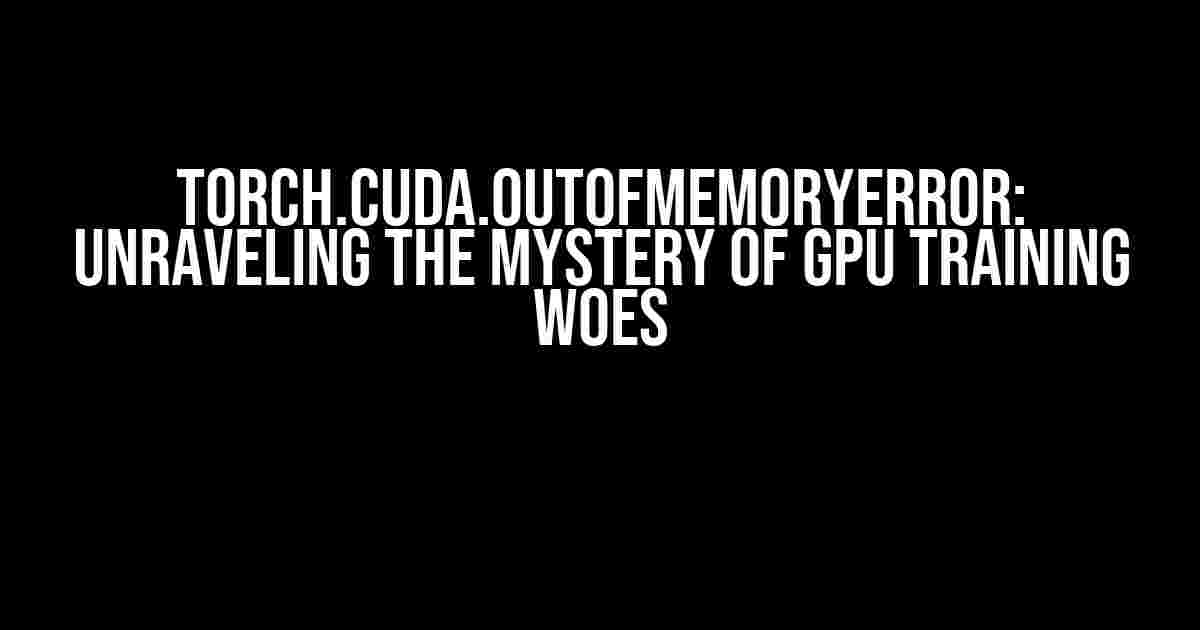Are you frustrated with the pesky Torch.cuda.OutOfMemoryError that pops up when training your model on a GPU, only to disappear when you switch to a CPU with larger batch sizes? You’re not alone! Many deep learning enthusiasts have encountered this enigmatic issue, and today, we’re going to demystify the causes and provide you with actionable solutions to overcome this hurdle.
The Anatomy of Torch.cuda.OutOfMemoryError
Before we dive into the solutions, let’s understand what this error means. Torch.cuda.OutOfMemoryError occurs when the GPU runs out of memory to allocate for your model’s training. Yes, you read that right – it’s a memory issue, not a model complexity one! The error message typically looks like this:
RuntimeError: CUDA out of memory. Tried to allocate 123.00 MiB (GPU 0; 11.17 GiB total capacity; 9.20 GiB already allocated; 1.34 GiB free; 10.12 GiB reserved in total by PyTorch)
Notice how it highlights the GPU’s total capacity, already allocated memory, and the amount of memory required for the allocation that failed. This gives us a starting point to investigate the issue.
Why Does it Happen on GPU but Not on CPU?
Now, let’s explore why this error occurs on a GPU but not on a CPU, even with larger batch sizes. There are a few key differences between GPU and CPU architectures that contribute to this behavior:
- Memory Architecture: GPUs have a limited amount of dedicated video random access memory (VRAM), which is separate from the system’s RAM. This VRAM is used to store the model’s parameters, gradients, and activations during training. In contrast, CPUs use system RAM, which is generally more abundant.
- Memory Allocation: When you train a model on a GPU, PyTorch allocates memory for the model’s parameters, input data, and intermediate results. If the allocation fails, you get the OutOfMemoryError. On a CPU, memory allocation is less restrictive, making it easier to accommodate larger batch sizes.
- Batch Size and Memory Consumption: When you increase the batch size on a CPU, the memory consumption grows, but it’s still manageable within the system’s RAM. However, on a GPU, the same batch size can exceed the available VRAM, leading to the error.
Solutions to Torch.cuda.OutOfMemoryError
Now that we’ve understood the causes, let’s dive into the solutions to this pesky error. We’ll explore a combination of model adjustments, data preparation tweaks, and infrastructure modifications to help you train your model on a GPU.
Model Adjustments
Here are some model-level adjustments to reduce memory consumption:
- Model Pruning: Remove redundant or unnecessary weights and connections to reduce the model’s size and memory footprint.
- Knowledge Distillation: Train a smaller, knowledge-distilled model that learns from a larger, pre-trained model. This can help reduce memory consumption.
- Mixed Precision Training: Use lower precision data types (e.g., float16) for model weights and activations to reduce memory usage. PyTorch provides built-in support for mixed precision training.
Data Preparation Tweaks
These data preparation tweaks can help reduce memory consumption:
- Data Augmentation on-the-fly: Instead of pre-computing and storing augmented data, perform augmentation on-the-fly during training. This reduces memory usage and can be done using PyTorch’s DataLoader.
- Batching and Prefetching: Implement batching and prefetching to load data in chunks, reducing peak memory usage. PyTorch’s DataLoader and prefetching functionality can help with this.
- Data Compression: Compress your dataset using techniques like image compression or data encoding to reduce storage requirements.
Infrastructure Modifications
Here are some infrastructure-level modifications to help you train on a GPU:
- Upgrade to a GPU with More VRAM: If possible, upgrade to a GPU with more VRAM (e.g., from 8GB to 16GB) to provide more memory for model training.
- Distributed Training: Distribute the model training across multiple GPUs using PyTorch’s DistributedDataParallel module. This can help utilize the collective VRAM of multiple GPUs.
- Gradient Checkpointing: Implement gradient checkpointing to store only necessary gradients and reduce memory consumption during backpropagation.
Batch Size Optimization
Let’s explore how to optimize batch size for GPU training:
When you encounter the OutOfMemoryError, try reducing the batch size to a smaller value, such as 16 or 32. This will decrease memory consumption, making it possible to train on a GPU. However, be aware that smaller batch sizes might affect model convergence and performance.
To find the optimal batch size, you can use the following approach:
- Start with a small batch size (e.g., 16) and gradually increase it until you encounter the OutOfMemoryError.
- Reduce the batch size by half and retrain the model.
- Repeat steps 1-2 until you find a batch size that allows training on a GPU without errors.
Remember, the optimal batch size will depend on your specific model, dataset, and GPU architecture.
Conclusion
Torch.cuda.OutOfMemoryError can be a frustrating obstacle when training models on a GPU. However, by understanding the underlying causes and applying the solutions outlined in this article, you can overcome this error and successfully train your model on a GPU.
Remember to monitor your GPU’s memory usage, adjust your model architecture and batch size accordingly, and explore data preparation tweaks and infrastructure modifications to optimize your training process.
Happy training, and don’t let the OutOfMemoryError hold you back!
| Solution Category | Solution | Description |
|---|---|---|
| Model Adjustments | Model Pruning | Remove redundant weights and connections to reduce model size |
| Knowledge Distillation | Train a smaller model that learns from a larger, pre-trained model | |
| Mixed Precision Training | Use lower precision data types to reduce memory usage | |
| Data Preparation Tweaks | Data Augmentation on-the-fly | Perform augmentation during training to reduce memory usage |
| Batching and Prefetching | Load data in chunks to reduce peak memory usage | |
| Data Compression | Compress dataset using techniques like image compression or data encoding | |
| Infrastructure Modifications | Upgrade to a GPU with More VRAM | Upgrade to a GPU with more VRAM for more memory |
| Distributed Training | Distribute training across multiple GPUs for collective VRAM | |
| Gradient Checkpointing | Store only necessary gradients to reduce memory usage during backpropagation |
We hope this comprehensive guide has helped you understand and overcome the Torch.cuda.OutOfMemoryError. Happy training, and don’t forget to share your own experiences and solutions in the comments below!
Frequently Asked Question
Stuck with torch.cuda.OutOfMemoryError when training your model on GPU but not for larger batch sizes on CPU? Don’t worry, we’ve got you covered!
What is torch.cuda.OutOfMemoryError and why does it occur?
torch.cuda.OutOfMemoryError occurs when your GPU runs out of memory while trying to allocate more memory for your model. This usually happens when you’re trying to train a large model or use a large batch size, exceeding the available memory on your GPU.
Why doesn’t this error occur on CPU with larger batch sizes?
CPUs have a much larger memory capacity compared to GPUs. When you train your model on the CPU, it can allocate memory from the system’s RAM, which is typically much larger than the GPU’s VRAM. This allows for larger batch sizes without running out of memory.
How can I fix torch.cuda.OutOfMemoryError without reducing my batch size?
You can try model prune, knowledge distillation, or gradient checkpointing to reduce the memory usage of your model. You can also use mixed precision training, which uses lower precision data types to reduce memory usage. Lastly, consider upgrading to a GPU with more VRAM or using a distributed training setup.
Can I use a larger batch size on GPU if I reduce the precision of my model?
Yes, using lower precision data types can help reduce memory usage, allowing for larger batch sizes on GPU. You can use PyTorch’s AMP (automatic mixed precision) or Apex to easily switch to lower precision data types like FP16.
Where can I find more resources to troubleshoot torch.cuda.OutOfMemoryError?
You can find more resources on PyTorch’s documentation, official forums, and Stack Overflow. There are also many online tutorials and blogs that provide tips and tricks for optimizing memory usage and troubleshooting OutOfMemoryError.


